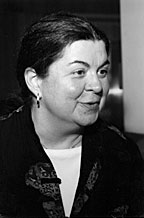|
HOME | SEARCH | ARCHIVE |
|
Researchers look for ways
to combat congestion
Transportation
experts, legislators hold town hall meeting
By Diane Ainsworth, Public Affairs
| |
|
24 Jan 2001 | Transportation officials, Bay area legislators, Berkeley scholars and community groups "need to get going" on better ways of planning for a surge of new commuters in California over the next 20 years, according to Elizabeth Deakin, a professor of city and regional planning and director of the UC Berkeley Transportation Center.
With its booming economy and nearly $13 billion state surplus last year, California should be spending more of its jackpot on new transportation systems - rapid transit, buses, highways and bikeways - to manage growth and ease traffic congestion, she maintains.
"Instead, we're spending 80 percent of our transportation budget on maintenance of existing transportation systems and showing a $30 billion deficit in the transportation projects we want to undertake," she told a group of about 400 participants during a two-day town meeting Jan. 17-18 on California's transportation challenges.
The town hall meeting, titled "Combating Congestion: Finding Regional Solutions to a Statewide Problem," was held in Sacramento and Berkeley to bring policymakers together with industry experts, campus scholars and community advocacy groups to address new approaches and technologies to solve traffic gridlock. Moderated by state Sen. Patrick Johnston, Institute of Governmental Studies legislator in residence, the discussions were sponsored by several Berkeley research institutes: the Institute of Urban and Regional Development, the University of California Transportation Center, the Institute of Transportation Studies and the Institute of Governmental Studies.
Panelists traveled to the state capitol to present a package of recommendations to Sen. Betty Karnette, chairwoman of the Senate Transportation Committee, and Assemblyman John Dutra, chairman of the Assembly Transportation Committee, who co-hosted the conference. They reconvened at Berkeley the following day to continue their discussion of strategies for building an efficient and equitable transportation system for 50-million-plus residents in the year 2020.
"We're up against fast growth, especially in major cities like Los Angeles, San Francisco and the Bay Area, Sacramento, and increasingly in San Diego, and a very fast rate of population change continued from page 1 in some cities in the Central Valley, such as Stockton, which is expected to double in population in the next 20 years," Deakin said. "And right now we don't have a regional vision, or a set of priorities for the way we want growth to occur, that will solve our transportation problems."
With 33 million residents, the great majority of whom live within 30 miles of the Pacific Coast, California is the nation's most populous state. Demographers predict that the state population will swell in the next two decades, attracting another18 million new residents due to immigration, a surge in the birth rate and the booming rate at which the Internet capitol of the world - Silicon Valley - is expanding.
"We don't have the proper incentives to encourage local governments to work together in planning for their transportation needs," Deakin said. "Transportation doesn't pay attention to local government boundaries, yet we have local cities and counties all planning for their own growth and transportation systems independently of one another, rather than looking to the region as a whole."
To encourage collaborative partnerships among city and county governments, Judith Gruber, a Berkeley political scientist, urged local officials to think of their cities as part of a regional corridor. "We're going to have to find incentives to encourage this way of thinking, so that cities and counties are given funding to come up with plans that address transportation corridors and multiple jurisdictions," Gruber said.
"The I-80 corridor is a good example," Deakin said. "That region stretches from Sacramento to Davis, down into Fairfield, Vallejo, Berkeley, Oakland and San Francisco. It crosses several jurisdictions and means that Caltrans, local governments and transit agencies should be working together to determine where they want growth to occur."
BART carries about 350,000 riders a day. The majority of the ridership travels to and from San Francisco, Oakland and Berkeley. "We wouldn't have the city of San Francisco as we know it without BART," Deakin said. "But with that said, some of the proposed BART extensions would be costly because they aren't going to attract a lot of ridership unless local governments change their plans for development around the BART stations.
"Before we consider expanding BART, we should look at where it's going to go, and how we can get people to those BART stations," she said. "We need to think about ways of providing really good door-to-door service, not just within each county or city, but within corridors."
Wisconsin has adopted a successful incentive for encouraging cities and counties to team up, said Judith Innes, director of Berkeley's Institute of Urban and Regional Development. "The state gives local governments money to pay for their new transportation plans if they present strategies that embrace neighboring cities and counties."
Other states held up
as models of effective transportation management included Utah, which
bases its transportation budgets, in part, on the tourist industry.
Home | Search | Archive | About | Contact | More News
Copyright 2001, The Regents of the University of California.
Produced and maintained by the Office of Public Affairs at UC Berkeley.
Comments? E-mail berkeleyan@pa.urel.berkeley.edu.
